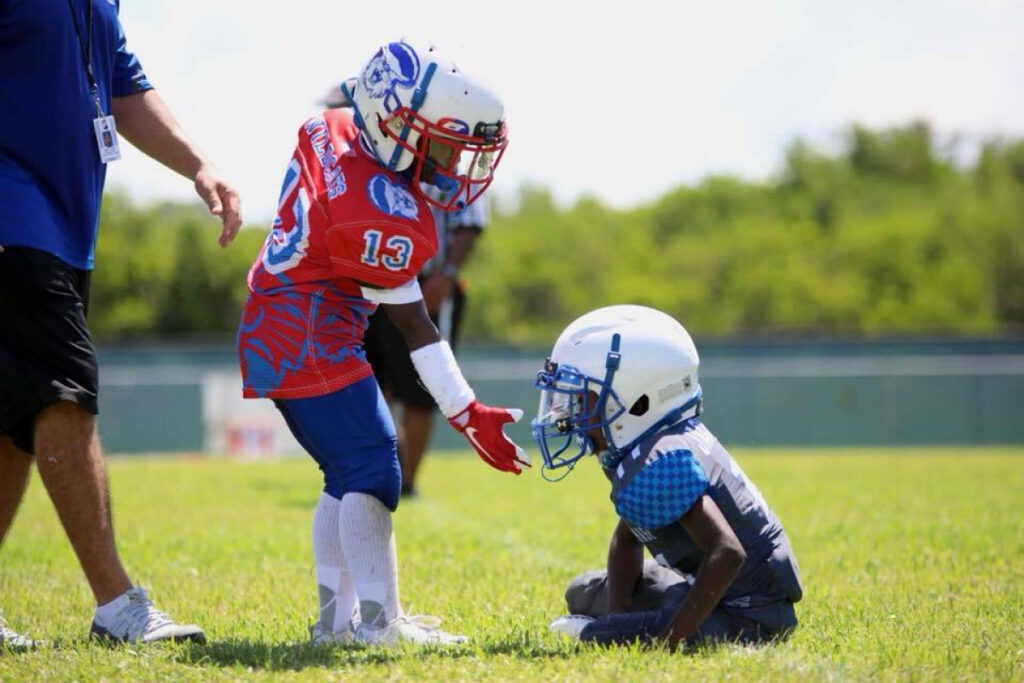Winner of the Highlight Challenge – Week 9: Dawson Witherspoon – Mount Vernon High School
Winner of the Highlight Challenge – Week 9: Dawson Witherspoon – Mount Vernon High School

Football has always been an intense and physically demanding sport. With players becoming faster, stronger, and more agile over the years, the risk of injury—particularly to the head—has grown. Fortunately, as the game has evolved, so too have the helmets designed to protect players. The journey from the earliest leather caps to today’s high-tech helmets is a fascinating reflection of how technology and safety have become integral to the sport.
In the late 1800s, football players didn’t wear helmets at all. It wasn’t until the early 1900s that the first form of head protection appeared: soft leather caps. These early helmets were primarily used to prevent skull fractures and superficial cuts, but they did little to protect players from concussions or other brain injuries. The lack of padding and structure meant that while they provided some comfort, the actual protection was minimal.
By the 1930s and 1940s, football helmets began to undergo significant changes. The introduction of hard, molded plastic shells marked a turning point in helmet safety. These helmets offered better protection against the increasingly physical nature of the game, helping to reduce skull fractures and head trauma. Inside, padding became thicker and more advanced, offering players more comfort and a slight improvement in concussion prevention.
In 1943, the NFL made helmets mandatory, pushing innovation forward. This era saw the first chin straps and face masks, which protected not only the skull but also the face from injuries.
In the 1970s, helmet technology took another leap forward with the development of foam padding and air cushioning systems. Helmets were becoming more sophisticated, with multi-layered padding designed to absorb and disperse the force of impacts. Air-bladder systems were introduced to help reduce concussive forces, creating a better fit and more adaptable cushioning for each player.
This period also saw the rise of face masks with multiple bars to protect the jaw and nose, further improving safety.
In recent years, football helmets have become the product of cutting-edge science and engineering. Today’s helmets are designed to do far more than just prevent fractures; they are built to actively reduce the risk of concussions and other traumatic brain injuries.
Advanced materials such as carbon fiber, thermoplastics, and impact-absorbing foam are now standard. Many helmets are equipped with innovative systems like shock absorbers and custom-fitted padding, allowing them to dissipate the force of impact more effectively. Helmet designs have also become more aerodynamic, which helps minimize the movement of the head and neck during collisions.
One of the most significant recent advancements has been the introduction of sensors and data-driven technologies within helmets. These sensors can monitor the force and location of impacts during a game, providing valuable information to teams, trainers, and medical professionals. This data helps identify potential injuries in real time and assists in research aimed at reducing concussions.
As awareness of concussion risks continues to grow, the future of helmet design looks promising. Companies are developing smart helmets that can provide even more detailed data on impacts, helping to fine-tune safety protocols and improve equipment.
Helmet manufacturers are exploring new materials that can further absorb impact forces, as well as new ways to minimize rotational forces (which are often the cause of concussions). The goal is to create helmets and/or product to be use in conjuction with helmets, that not only protect players during a collision but also reduce the risk of long-term brain injuries.
Football helmets have come a long way from the simple leather caps of the early 1900s. Today, they are high-tech pieces of equipment designed with one goal in mind: protecting athletes from serious head injuries. As technology continues to advance, we can expect helmets and helmet adjacent products to become even more effective at keeping players safe without compromising the integrity or excitement of the game.
While no helmet can eliminate the risk of injury, the evolution of football helmets has shown that with the right innovations, the game can become safer for future generations of players.
To learn more about how wearing the G8RSkin Sheisty under a helmet, please visit our Science and Testing page.